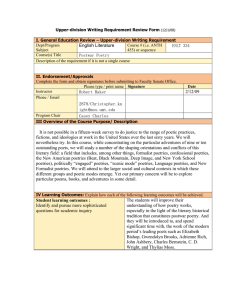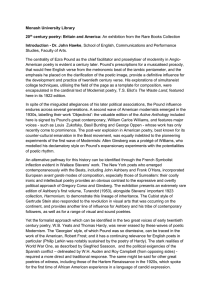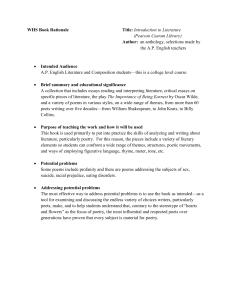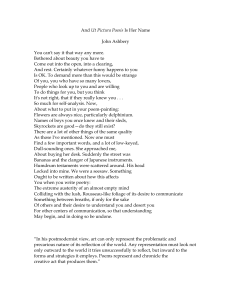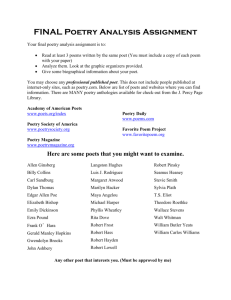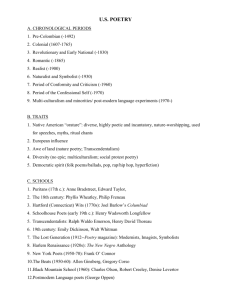Document 11902844
advertisement
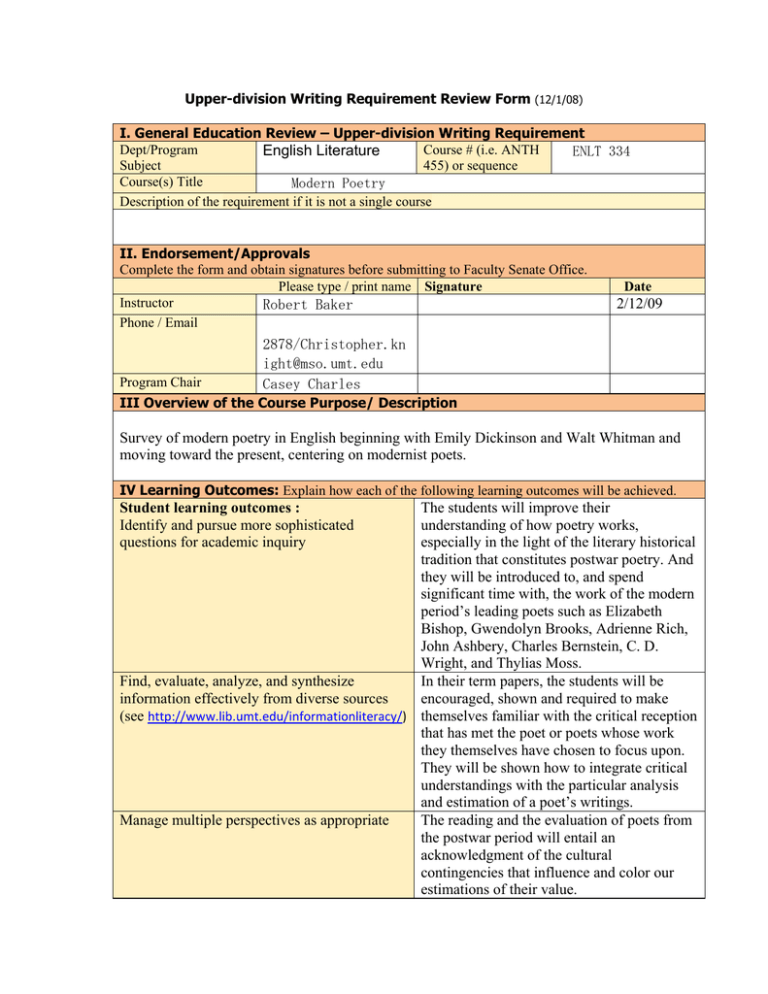
Upper-division Writing Requirement Review Form (12/1/08) I. General Education Review – Upper-division Writing Requirement Dept/Program Course # (i.e. ANTH English Literature ENLT 334 Subject 455) or sequence Course(s) Title Modern Poetry Description of the requirement if it is not a single course II. Endorsement/Approvals Complete the form and obtain signatures before submitting to Faculty Senate Office. Please type / print name Signature Instructor Robert Baker Phone / Email Program Chair Date 2/12/09 2878/Christopher.kn ight@mso.umt.edu Casey Charles III Overview of the Course Purpose/ Description Survey of modern poetry in English beginning with Emily Dickinson and Walt Whitman and moving toward the present, centering on modernist poets. IV Learning Outcomes: Explain how each of the following learning outcomes will be achieved. The students will improve their understanding of how poetry works, especially in the light of the literary historical tradition that constitutes postwar poetry. And they will be introduced to, and spend significant time with, the work of the modern period’s leading poets such as Elizabeth Bishop, Gwendolyn Brooks, Adrienne Rich, John Ashbery, Charles Bernstein, C. D. Wright, and Thylias Moss. Find, evaluate, analyze, and synthesize In their term papers, the students will be information effectively from diverse sources encouraged, shown and required to make (see http://www.lib.umt.edu/informationliteracy/) themselves familiar with the critical reception that has met the poet or poets whose work they themselves have chosen to focus upon. They will be shown how to integrate critical understandings with the particular analysis and estimation of a poet’s writings. Manage multiple perspectives as appropriate The reading and the evaluation of poets from the postwar period will entail an acknowledgment of the cultural contingencies that influence and color our estimations of their value. Student learning outcomes : Identify and pursue more sophisticated questions for academic inquiry Recognize the purposes and needs of discipline-specific audiences and adopt the academic voice necessary for the chosen discipline Use multiple drafts, revision, and editing in conducting inquiry and preparing written work Follow the conventions of citation, documentation, and formal presentation appropriate to that discipline Develop competence in information technology and digital literacy V. Writing Course Requirements Check list Is enrollment capped at 25 students? If not, list maximum course enrollment. Explain how outcomes will be adequately met for this number of students. Justify the request for variance. Are outcomes listed in the course syllabus? If not, how will students be informed of course expectations? Are detailed requirements for all written assignments including criteria for evaluation in the course syllabus? If not how and when will students be informed of written assignments? Briefly explain how students are provided with tools and strategies for effective writing and editing in the major. The students will learn that postwar poetry as it is understood in the American and British literature curriculum entails a range of forms and expectations that are not necessarily synonymous with all verse that happens to be written in the period extending from Elizabeth Bishop to the present. They, in turn, will be instructed in the range of critical voices that they themselves can assume, if they wish to have their own work register as participating in the discipline’s framework, developing as this might be. As a lengthy critical research paper is required, the students will be moved in the direction of thinking through his or her writing as entailing a series of stages involving drafts and revision, done with feedback from, and in consultation with, the professor. The students will be made more familiar with and required to use the Modern Language Association requirements for documenting their work. As many of the poets studied have recorded their work, the students will have the opportunity to listen to such recordings not only in the classroom but also via tapes available both from the library and on the internet. The course is capped at 30 in keeping with current writing course criteria. We hope to change that cap to 25 with the next offering of the course. Yes Yes The students are provided with specific prompts that are designed both to enhance their understanding of the assumptions pertaining to modern poetry and to focus their own research, strengthening both their theses and supporting arguments. Will written assignments include an opportunity for Yes revision? If not, then explain how students will receive and use feedback to improve their writing ability. Are expectations for Information Literacy listed in They will be informed both in a term paper the course syllabus? If not, how will students be assignment sheet and verbally. informed of course expectations? VI. Writing Assignments: Please describe course assignments. Students should be required to individually compose at least 20 pages of writing for assessment. At least 50% of the course grade should be based on students’ performance on writing assignments. Clear expression, quality, and accuracy of content are considered an integral part of the grade on any writing assignment. Formal Graded Assignments Two short papers (5-7 pp); one long paper Informal Ungraded Assignments (10-15 pp) None VII. Syllabus: Paste syllabus below or attach and send digital copy with form. ⇓ The syllabus should clearly describe how the above criteria are satisfied. For assistance on syllabus preparation see: http://teaching.berkeley.edu/bgd/syllabus.html Paste syllabus here. English 430 Contemporary Poetry Fall 2007 TR 2:10 -3:30 JOUR 306 Robert Baker (243-6973 / 543-1045) Office Hours: TR 3:30 – 5:00, W 10:30 – 1:00, and by appointment (LA 219) It is not possible in a fifteen-week survey to do justice to the range of poetic practices, fictions, and ideologies at work in the United States over the last sixty years. We will nevertheless try. In this course, while concentrating on the particular adventures of nine or ten outstanding poets, we will study a number of the shaping orientations and conflicts of this literary field: a field that includes, among other things, formalist poetries, confessional poetries, the New American poetries (Beat, Black Mountain, Deep Image, and New York School poetries), politically “engaged” poetries, “scenic mode” poetries, Language poetries, and New Formalist poetries. We will attend to the larger social and cultural contexts in which these different groups and poetic modes emerge. Yet our primary concern will be to explore particular poems, books, and adventures in some detail. Course Requirements Regular attendance and bright alertness Careful reading of all the assigned texts Two short papers (5-7 pages) One long paper (10-15 pages) Required Texts Elizabeth Bishop, The Complete Poems Gwendolyn Brooks, Blacks Allen Ginsberg, Howl Adrienne Rich, The Dream of a Common Language John Ashbery, The Mooring of Starting Out: The First Five Books of Poetry John Ashbery, Self-Portrait in a Convex Mirror Charles Bernstein, Controlling Interests C.D. Wright, Deepstep Come Shining Thylias Moss, Tokyo Butter Handouts of poems by other authors Critical essays in course packet (on reserve at Mansfield Library and on shelf beside my office) Map of Course Note: Note: nothing below is fixed in stone: there may be changes along the way h = handout (there are likely to be handouts along the way that are not marked on this map) cp = course packet T AUG 28 Introduction - shape of course - questions of literary history R AUG 30 Introduction - contexts of early postwar period - early postwar formalist poetries Modern to * * Poems by Richard Wilbur, Adrienne Rich, James Merrill, Anthony Hecht (h) James Breslin, “Preface,” “The End of the Line,” “The New Rear Guard” from From Contemporary (cp 1) * T SEPT 4 Bishop, North & South R SEPT 6 Bishop, A Cold Spring T SEPT 11 Bishop, Questions of Travel Vendler, “Elizabeth Bishop” (cp 3) R SEPT 13 Bishop, Geography III T SEPT 18 Brooks, A Street in Bronzeville R SEPT 20 Brooks, Annie Allen T SEPT 25 Brooks, The Bean Eaters R SEPT 27 Brooks, In the Mecca, To Disembark Brooks, “Interview with Ida Lewis” (cp 5) Baker, “The Florescence of Nationalism in the 1960s and 1970s” (cp 5) * * * T OCT 2 Olson, “The Kingfishers” (h) and “Projective Verse” (cp 6) Davenport, “Charles Olson” (cp 6) *** Paper I Due *** R OCT 4 Olson, “The Kingfishers” (h) Duncan, “Poem Beginning with a Line by Pindar” (h) Creeley, poems (h) Altieri, “Introduction” and “Symbolist and Immanentist Modes of Poetic Thought” from Enlarging the Temple (cp 6) T OCT 9 Ginsberg, Howl R OCT 11 Ginsberg, Howl T OCT 16 Rich, “Diving Into the Wreck” (h) and The Dream of a Common Language Rich, “Writing as Re-Vision” (cp 8) R OCT 18 Rich, The Dream of a Common Language T OCT 23 Ashbery, “Clepsydra,” The Double-Dream of Spring O’Hara, “Meditations in an Emergency,” “The Day Lady Died,” “You are Gorgeous and I’m Coming,” “To the Film Industry in Crisis” (h) Schuyler, poems (h) *** Paper II Due *** R OCT 25 Ashbery, The Double-Dream of Spring Ashbery, “Craft Interview” (cp 9) T OCT 30 Ashbery, Three Poems Bloom, “John Ashbery: The Charity of the Hard Moments” (cp 10) R NOV 1 Ashbery, Three Poems Perloff, “Barthes, Ashbery, and the Zero Degree of Genre” (cp 10) T NOV 6 Ashbery, Self-Portrait in a Convex Mirror R NOV 8 Ashbery, Self-Portrait in a Convex Mirror, “Daffy Duck in Hollywood” (h) * * * T NOV 13 Bernstein, Controlling Interests Bernstein, “Semblance” (cp 12) Bob Perelman, “Language Writing and Literary History” from The Marginalization of Poetry (cp 12) R NOV 15 Bernstein, Controlling Interests Fredric Jameson, “Postmodernism, or, The Cultural Logic of Late Capitalism” (cp 12) T NOV 20 Wright, Deepstep Come Shining Wright, “Interview” (cp 13) R NOV 22 Thanksgiving T NOV 27 Wright, Deepstep Come Shining R NOV 29 Moss, Tokyo Butter T DEC4 Moss, Tokyo Butter R DEC 6 Review *** Paper III Due on Monday 10 December by noon *** University Policy on Academic Honesty: All students must practice academic honesty. Academic misconduct is subject to an academic penalty by the course instructor and/or a disciplinary sanction by the University. All students need to be familiar with the Student Conduct Code. The Code is available for review online at http://www.umt.edu/SA/VPSA/index.cfm/age/1321. University Plagiarism Warning: “Plagiarism is the representing of another’s work as one’s own. It is a particularly intolerable offense in the academic community and is strictly forbidden. Students who plagiarize may fail the course and may be remanded to Academic Court for possible suspension or expulsion. (See Student Code section of the University catalogue.) “Students must always be very careful to acknowledge any kind of borrowing that is included in their work. This means not only borrowed wording but also ideas. Acknowledgment of whatever is not one’s own original work is the proper and honest use of sources. Failure to acknowledge whatever is not one’s own original work is plagiarism.” Standard University Grading Criteria A Paper: Perhaps the principle characteristic of the A paper is its rich content. Some people describe that content as “meaty,” others as “dense,” still others as “packed.” Whatever, the information delivered is such that one feels significantly taught by the author, sentence after sentence, paragraph after paragraph. The A paper is also marked by stylistic finesse; the title and opening paragraph are engaging; the transitions are artful; the phrasing is tight, fresh, and highly specific; the sentence structure is varied; the tone enhances the purpose of the paper. Finally, the A paper, because of its careful organization and development, imparts a feeling of wholeness and unusual clarity. Not surprisingly, then, it leaves the reader feeling bright, thoroughly satisfied, and eager to reread the piece. B Paper: It is significantly more than competent. Besides being almost free of mechanical errors, the B paper delivers substantial information—that is, substantial in both quantity and interest-value. Its specific points are logically ordered, well developed, and unified around a clear organizing principle that is apparent early in the paper. The opening paragraph draws the reader in; the closing paragraph is both conclusive and thematically related to the opening. The transitions between paragraphs are for the most part smooth, the sentence structures pleasingly varied. The direction of the B paper is typically much more concise and precise than that found in the C paper. Occasionally, it even shows distinctiveness—i.e., finesse and memorability. On the whole, then, a B paper makes the reading experience a pleasurable one, for it offers substantial information with few distractions. C Paper: It is generally competent—it meets the assignment, has few mechanical errors, and is reasonably well organized and developed. The actual information it delivers, however, seems thin and commonplace. One reason for that impression is that the ideas are typically cast in the form of vague generalities—generalities that prompt the confused reader to ask marginally: “In every case?” “Exactly how large?” “Why?” “But how many?” Stylistically, the C paper has other shortcomings as well: the opening paragraph does little to draw the reader in; the final paragraph offers only a perfunctory wrap-up; the transitions between the paragraphs are bumpy; the sentences, besides being a bit choppy, tend to follow a predictable (hence monotonous) subject-verb-object; and the diction is occasionally marred by unconscious repetitions, redundancy, and imprecision. The C paper, then, while it gets the job done, lacks both imagination and intellectual rigor, and hence does not invite a rereading. D Paper: Its treatment and development of the subject are as yet only rudimentary. While organization is present, it is neither clear nor effective. Sentences are frequently awkward, ambiguous, and marred by serious mechanical errors. Evidence of careful proofreading is scanty, if nonexistent. The whole piece, in fact, often gives the impression of having been conceived and written in haste. F Paper: Its treatment of the subject is superficial; its theme lacks discernible organization; its prose is garbled or stylistically primitive. Mechanical errors are frequent. In short, the ideas, organization, and style fall far below what is acceptable in college writing.
